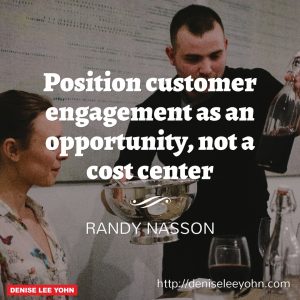In preparing for a talk to a group of customer contact center managers, I’ve come to the conclusion that customer service ain’t what it used to be. There is a brand of new customer service in play today.
Time was, customer service was a post-purchase business function aimed at fixing customers problems. The ultimate goal was service recovery — that is, correcting a problem well enough that the customer would be satisfied and return to purchase again.
Today, new customer service is a critical element of customer experience, woven throughout the customer journey — with the goals of not only restoring the customer with the problem but also differentiating the brand, increasing perceived brand value, and contributing to sales and marketing efforts.
An illuminating summary of this new customer service reality comes from @RandyNasson in a recent piece, The Transition from Customer Service to Strategic Sales. “When it comes to connecting with customers online, a number of multichannel and ecommerce retailers are still stuck in the ‘customer support’ mindset; one that views contact with a customer as a necessary evil rather than an opportunity,” Randy writes. “Most businesses view customer service as a cost center. .. Making the transition from support to sales requires a strategic mind shift within your organization in which customer engagements are viewed as growth opportunities.”
To embrace these growth opportunities, Randy explains, “This may require agent training or new hires if your current contact center model is based on troubleshooting and rapid resolution rather than customer experience. It may also require broader organizational alignment to facilitate this transition and prevent lack of ownership or internal politics from undermining potential gains.”
@blakemichellem adds that customer service agents must learn soft skills. In 5 Tips To Scale Soft Skills Training For Your Customer Service Team, Blake writes, “Don’t think for one second your customer service agents aren’t part of the sales process. Every single experience, every single touch point, and every single conversation the customer has with your company—has an impact on how that customer views your company. Every interaction that customer is deciding two things: if they ever want to work with you again, if they would recommend you to anyone else.” She goes on to provide five tips for hiring and training agents to have “the best people skills on the planet” — it’s a very helpful read.
Another way to facilitate the transition to a more proactive, brand-building approach to customer service is provided by @toister in The Preemptive Acknowledgement. The “Preemptive Acknowledgement,” Jeff writes, “is the customer service professional’s secret weapon against negative emotions,” and he explains it involves three steps: “Spot a problem before the customer gets angry. Acknowledge the situation before the customer complains. Re-focus on a solution.”
Two additional pieces emphasize the multi-dimensional and emotional nature of the new customer service today. In a HuffPo piece, @rhondasharf encourages companies to be aware fast customer service is not always adequate. “Speed is not the only way to evaluate efficiency…Customer service matters in efficiency. Attitude, accuracy and empathy matter. Smart systems, processes and deliveries matter.”
And @jeannebliss explains how apologies from companies need to be just as robust. In We Want You Back – How To Prove It To Your Customers, Jeanne writes, “The speed, content and tone of a company’s apology is crucial in a digitally connected world. Your motivation is to make customers whole — to earn the right to continue the relationship. However, repairing the emotional connection with customers in distress can be costly…Don’t consider the job done until the emotional connection with customers is restored.”
Learn more about modern customer service from brand book bites from “Hug Your Haters”, my write-up and author interview with Jay Baer on his new book.
The post customer service ain’t what it used to be appeared first on Denise Lee Yohn.











